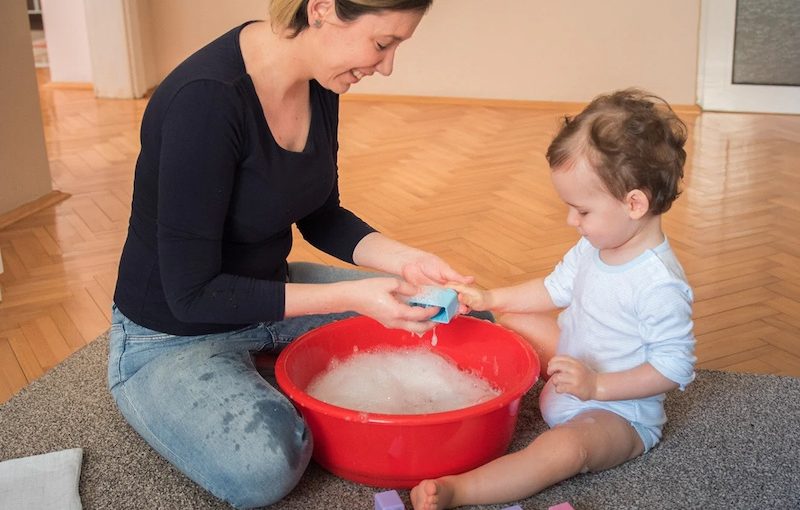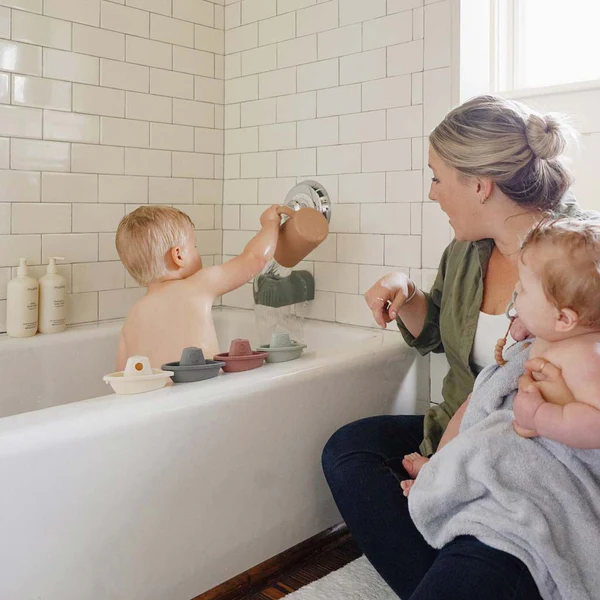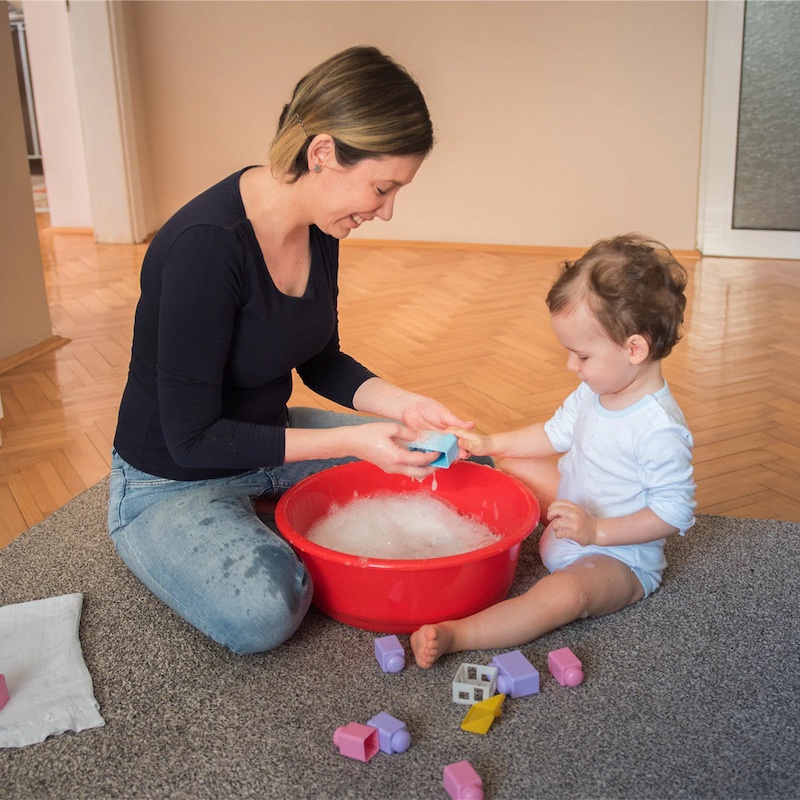Why Sanitizing Bath Toys is Important
Ensuring your children’s bath toys are clean is not just a matter of tidiness; it’s crucial for their health. Bath toys come into direct contact with your child’s skin and mouth. This can pose a risk of infection if the toys harbor harmful germs. Toys that remain wet are breeding grounds for bacteria, mold, and mildew.
Sanitizing bath toys reduces the spread of germs. Kids have developing immune systems and are more susceptible to infections. Keeping their playthings sanitized helps protect them from getting sick. Regular cleaning also extends the life of the toys, saving you money in the long run. Knowing how to sanitize bath toys effectively ensures a safe and enjoyable bath time for your little ones.
Common Germs Found on Bath Toys
Bath toys may seem innocent, but they can hide nasty germs. Common bacteria like E. coli and Staphylococcus aureus often lurk on these toys. These can cause skin infections or stomach upsets in young children. Soap scum and fecal matter tend to cling to toys. These create a welcoming environment for pathogens to multiply. Fungi such as Candida can also be found, leading to infections like thrush. Mold and mildew aren’t just unsightly, they can cause respiratory issues. These organisms flourish in warm, moist environments like bathrooms. Knowing how dangerous these germs can be underscores the need to sanitize bath toys regularly. By cleaning them properly, you can eliminate these risks and keep your children safe.
Step-by-Step Guide to Cleaning Bath Toys
Cleaning bath toys properly is vital for your child’s health. Here is a simple guide on how to sanitize bath toys effectively:
- Empty the toys: Begin by squeezing out all the water. This helps prevent mold and bacteria from growing inside.
- Prepare a cleaning solution: Mix 1/2 cup of white vinegar with a gallon of warm water. Vinegar is a natural disinfectant that kills most germs without harsh chemicals.
- Submerge the toys: Place the toys in the vinegar solution. Ensure that they are completely covered. Let them soak for at least an hour to kill any bacteria or mold.
- Scrub the toys: After soaking, use a clean brush or sponge to scrub the toys. Pay attention to crevices where mold can hide.
- Rinse thoroughly: Rinse the toys under warm running water. Make sure all vinegar solution is washed off to avoid any residue.
- Disinfect with heat: If the toys are heat-safe, put them in the dishwasher. Use a gentle cycle with a hot water setting to sanitize them effectively.
- Dry completely: After cleaning, dry the toys completely. You can let them air-dry or use a towel to remove any moisture.
Following these steps will help ensure that your children’s bath toys remain free of germs. Regular cleaning keeps toys safe for play and extends their usability.
Natural Cleaning Solutions for Bath Toys
Choosing natural cleaning solutions is a safe way to disinfect bath toys. These options avoid harsh chemicals that could harm your child. Here are some natural methods for sanitizing bath toys:
- White Vinegar Mixture: As mentioned before, mixing white vinegar with warm water creates a natural disinfectant. Use it to soak and scrub the toys. It breaks down grime and kills germs effectively.
- Baking Soda Paste: Make a paste using baking soda and water. Apply this to the toys and scrub gently. Baking soda is great for removing tough stains and neutralizing odors.
- Tea Tree Oil Solution: A few drops of tea tree oil in water can make a powerful cleaner. It has antifungal and antibacterial properties. Always rinse toys well after using this solution.
- Thyme Oil Blend: Thyme oil has natural antimicrobial properties. Mixed with water, it can be a potent disinfectant. Be sure to dilute it properly and rinse toys afterward.
- Hydrogen Peroxide Soak: Hydrogen peroxide can help to sanitize bath toys too. Soak the toys in a mixture of hydrogen peroxide and water. It helps to kill bacteria and viruses.
Using natural solutions ensures that you know exactly what’s cleaning your child’s toys. They’re gentle for the toys, your child, and the environment. Make sure to use the correct concentrations and always rinse the toys thoroughly to prevent any residue. Regularly using these natural methods will help to keep bath toys clean and free from harmful germs.
Best Practices for Drying and Storing Bath Toys
After you sanitize bath toys, drying and storing them correctly is crucial. This prevents germ buildup and extends toy life. Here are best practices for drying and storing bath toys effectively:
- Dry them fully: Ensure each toy is completely dry before storage. Lingering moisture can lead to mold.
- Use a towel: Gently pat the toys down with a clean towel to remove excess water.
- Air-dry in a well-ventilated area: Place the toys in a spot with good airflow. This speeds up drying.
- Avoid closed containers: Storing wet toys in closed containers promotes mold growth. Make sure toys are dry first.
- Mesh bags or open baskets: Consider using mesh bags or baskets for storing bath toys. They allow air circulation to keep toys dry.
- Regular checks: Frequently check toys for moisture or mold, even when not in use.
- Sunlight: Occasionally, let the toys dry in the sunlight. Sunlight is a natural disinfectant.
- Avoid humid places: Store toys outside of the bathroom if it’s particularly humid.
By following these drying and storage tips, you help ensure that bath toys stay clean and safe for your children. Practice these tips after each use, and combine them with regular sanitization methods for the best results.
Tips to Prevent Mold and Mildly
Preventing mold and mildew on bath toys is easier than it might seem. Here are a few practical tips:
- Ensure Good Airflow: After bath time, place toys in an area with good ventilation. This allows them to dry faster, reducing the chance for mold to grow.
- Squeeze Out Water: Always make sure you squeeze every drop of water from the toys. This step is crucial to prevent water from sitting inside and becoming a mold haven.
- Use Bleach Sparingly: Occasionally, you can use a mild bleach solution to rinse the toys. Do this to kill any existing mold spores. But remember, always rinse toys well after this step.
- Regular Inspections: Check your toys often for signs of mold or mildew. By catching it early, you can clean the toys before the problem worsens.
- Keep Toys Dry: When not in use, store the toys in a dry place. High moisture areas, like bathrooms, are not ideal for toy storage.
- Avoid Bath Toy Damage: Broken toys can trap water, so dispose of any damaged ones. Keeping the toys intact helps prevent mold growth inside.
- Limit Bath Toy Numbers: The fewer toys you have, the easier it is to maintain them. Give each toy its turn in the bath to avoid overcrowding and ensure proper drying.
- Clean the Bath Area Regularly: A clean tub means cleaner toys. Wipe down the bath area often to keep it free from soap scum and residue.
Incorporating these tips into your routine can greatly reduce the risk of mold and mildew on bath toys, keeping them safe and clean for your kids to enjoy.
When to Replace Bath Toys
While regular cleaning is essential, sometimes bath toys simply need replacing. Here are signs it’s time:
- Wear and Tear: If toys show cracks, they can trap water inside. Get rid of them.
- Permanent Stains: Stains might indicate mold below the surface. If cleaning doesn’t help, discard the toy.
- Persistent Odor: A musty or moldy smell, even after sanitizing, means the toy is compromised.
- Ineffective Squeakers: Water inside toys with squeakers can breed bacteria. If they stop working, toss them.
- Discoloration: Noticeable changes in a toy’s color can signal long-term water damage.
- Safety Recalls: Check for recalls. If a toy’s been recalled due to safety issues, replace it immediately.
It’s critical to monitor bath toys and decide when it’s time to introduce new, safe options for your child. The guidelines for how to sanitize bath toys help maintain a hygienic play environment, but it’s just as important to recognize when a toy has outlived its usefulness. By replacing old or damaged toys, you make bath time both fun and healthy for your little one.



